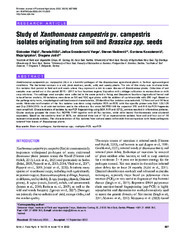| dc.creator | Vlajić, Slobodan | |
| dc.creator | Iličić, Renata | |
| dc.creator | Gvozdanović-Varga, Jelica | |
| dc.creator | Maširević, Stevan | |
| dc.creator | Kozoderović, Gordana | |
| dc.creator | Ignjatov, Maja | |
| dc.creator | Jošić, Dragana | |
| dc.date.accessioned | 2023-05-03T09:47:12Z | |
| dc.date.available | 2023-05-03T09:47:12Z | |
| dc.date.issued | 2022 | |
| dc.identifier.issn | 2079-052X | |
| dc.identifier.issn | 2079-0538 | |
| dc.identifier.uri | http://fiver.ifvcns.rs/handle/123456789/3470 | |
| dc.description.abstract | Xanthomonas campestris pv. campestris (Xcc) is a harmful pathogen of the Brassicaceae agricultural plants in Serbian agro-ecological conditions. The bacterium survives in a soil, plant residues, seeds, wild, and weedy plants. The aim of this study was to characterize Xcc isolates that persist in field soil and seeds where they represent a risk to cause disease of Brassicaceae plants. Collection of soil samples was carried out in the period 2015 - 2017 in four locations regions Vojvodina with cabbage cultivation in monoculture or with crop rotations. The cabbage seed samples were collected in the same period in Futog and Despotovo locations (agricultural farms) and in local farmer markets. All isolations were done on SX and YDC agar plates with the addition of cycloheximide with 250 mg/l. Based on the pathogenicity tests, morphological and biochemical characteristics, 28 identified Xcc isolates were selected, 12 from soil and 16 from seeds. Molecular confirmation of the Xcc isolates was done using multiplex PCR (m-PCR) with Xcc-specific primer sets DLH 120/125 and Zup 2309/2310. In all selected isolates and in the reference Xcc strain NCPPB1144 the expected 370 and 619 bp PCR fragments were amplified. Characterization of isolates by rep-PCR fingerprinting using BOX A1R and (GTG)5 primers resulted in informative patterns. Cluster analysis grouped the strain Xcc NCPPB 1144 together with all Xcc isolates, while other tested Xanthomonads were clustered separately. Based on the similarity level of 90%, we obtained three out of 12 as representative isolates from soil and four out of 16 representative seeds isolates. The characterization of Xcc isolates from soil and seeds will enable their comparison with those pathogenic isolated from leaves of Brassicaceae plants. | sr |
| dc.language.iso | en | sr |
| dc.publisher | United Arab Emirates University | sr |
| dc.relation | info:eu-repo/grantAgreement/MESTD/inst-2020/200032/RS// | sr |
| dc.relation | info:eu-repo/grantAgreement/MESTD/Integrated and Interdisciplinary Research (IIR or III)/46007/RS// | sr |
| dc.rights | openAccess | sr |
| dc.rights.uri | https://creativecommons.org/licenses/by/4.0/ | |
| dc.source | Emirates Journal of Food and Agriculture | sr |
| dc.subject | black rot | sr |
| dc.subject | pathogens | sr |
| dc.subject | Xanthomonas spp. | sr |
| dc.subject | multiplex-PCR | sr |
| dc.subject | rep-PCR | sr |
| dc.title | Study of Xanthomonas campestris pv. campestris isolates originating from soil and Brassica spp. seeds | sr |
| dc.type | article | sr |
| dc.rights.license | BY | sr |
| dc.citation.epage | 835 | |
| dc.citation.issue | 10 | |
| dc.citation.rank | M23 | |
| dc.citation.spage | 827 | |
| dc.citation.volume | 35 | |
| dc.identifier.doi | 10.9755/ejfa.2022.v34.i10.2923 | |
| dc.identifier.fulltext | http://fiver.ifvcns.rs/bitstream/id/9407/bitstream_9407.pdf | |
| dc.identifier.scopus | 2-s2.0-85153382319 | |
| dc.type.version | publishedVersion | sr |


